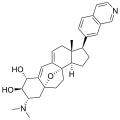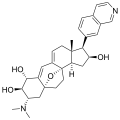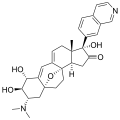Cortistatins
 | |
| Names | |
|---|---|
| IUPAC name
(1R,2R,3S,5R,8β,17β)-3-(Dimethylamino)-17-(isoquinolin-7-yl)-5,8-epoxy-9,19-cyclo-9,10-secoandrosta-9(11),10-diene-1,2-diol | |
| Other names
Cortistatine A | |
| Identifiers | |
| 882976-95-6 | |
| 3D model (Jmol) | Interactive image |
| ChEBI | CHEBI:67171 |
| ChemSpider | 9736681 |
| PubChem | 11561907 |
| |
| |
| Properties | |
| C30H36N2O3 | |
| Molar mass | 472.63 g·mol−1 |
| Except where otherwise noted, data are given for materials in their standard state (at 25 °C [77 °F], 100 kPa). | |
| Infobox references | |
The cortistatins are a group of steroidal alkaloids first isolated in 2006 from the marine sponge Corticium simplex.[1] The cortistatins were first discovered in a search for naturally-occurring compounds that inhibit proliferation of human umbilical vein endothelial cells (HUVECs), with cortistatin A being the most potent compound in the class.[2]
The Shair group at Harvard along with collaborators have shown that cortistatin A is a highly potent and selective inhibitor of CDK8 and CDK19, the kinases that associate with Mediator complex.[3] Out of 386 kinases evaluated, cortistatin A only inhibited CDK8 and CDK19, revealing that it is among the most selective kinase inhibitors. It was also shown that cortistatin A potently inhibits growth of acute myeloid leukemia cells and AML in two in vivo mouse models. Identification of dominant drug-resistant alleles of CDK8 and CDK19 demonstrate that these kinases mediate the activity of cortistatin A in AML cells. Thus, inhibition of CDK8 and CDK19 is a new therapeutic approach to AML. Cortistatin A caused selective and disproportionate up-regulation of super-enhancer-associated genes in AML cells which contributed to its anti-leukemic activity. This work indicated that CDK8 and CDK19 are negative regulators of super-enhancer-associated genes in AML.
Di-dehydrocortistatin A suppresses viral replication in cells infected with HIV via binding to the Tat protein.[4]
Cortistatin A was synthesized by the Shair,[5] Myers, Baran[6] and Nicolaou labs.
Chemical structures
 Cortistatin A
Cortistatin A Cortistatin B
Cortistatin B Cortistatin C
Cortistatin C Cortistatin D
Cortistatin D Cortistatin E
Cortistatin E Cortistatin F
Cortistatin F Cortistatin G
Cortistatin G Cortistatin H
Cortistatin H Cortistatin J
Cortistatin J Cortistatin K
Cortistatin K Cortistatin L
Cortistatin L
References
- ↑ Aoki, S; Watanabe, Y; Sanagawa, M; Setiawan, A; Kotoku, N; Kobayashi, M (2006). "Cortistatins A, B, C, and D, anti-angiogenic steroidal alkaloids, from the marine sponge Corticium simplex". Journal of the American Chemical Society. 128 (10): 3148–9. doi:10.1021/ja057404h. PMID 16522087.
- ↑ Aoki, S; Watanabe, Y; Tanabe, D; Arai, M; Suna, H; Miyamoto, K; Tsujibo, H; Tsujikawa, K; Yamamoto, H (2007). "Structure-activity relationship and biological property of cortistatins, anti-angiogenic spongean steroidal alkaloids". Bioorganic & Medicinal Chemistry. 15 (21): 6758–62. doi:10.1016/j.bmc.2007.08.017. PMID 17765550.
- ↑ Pelish, Henry E.; Liau, Brian B.; Nitulescu, Ioana I.; Tangpeerachaikul, Anupong; Poss, Zachary C.; Silva, Diogo H. Da; Caruso, Brittany T.; Arefolov, Alexander; Fadeyi, Olugbeminiyi. "Mediator kinase inhibition further activates super-enhancer-associated genes in AML". Nature. 526 (7572): 273–276. doi:10.1038/nature14904.
- ↑ Mousseau, G.; Clementz, M. A.; Bakeman, W. N.; Nagarsheth, N.; Cameron, M.; Shi, J.; Baran, P.; Fromentin, R. M.; Chomont, N.; Valente, S. T. (2012). "An Analog of the Natural Steroidal Alkaloid Cortistatin a Potently Suppresses Tat-Dependent HIV Transcription". Cell Host & Microbe. 12 (1): 97–108. doi:10.1016/j.chom.2012.05.016. PMC 3403716
 . PMID 22817991.
. PMID 22817991. - ↑ Lee, Hong Myung; Nieto-Oberhuber, Cristina; Shair, Matthew D. (2008-12-17). "Enantioselective Synthesis of (+)-Cortistatin A, a Potent and Selective Inhibitor of Endothelial Cell Proliferation". Journal of the American Chemical Society. 130 (50): 16864–16866. doi:10.1021/ja8071918. ISSN 0002-7863.
- ↑ Shenvi, Ryan A.; Guerrero, Carlos A.; Shi, Jun; Li, Chuang-Chuang; Baran, Phil S. "Synthesis of (+)-Cortistatin A". Journal of the American Chemical Society. 130 (23): 7241–7243. doi:10.1021/ja8023466.